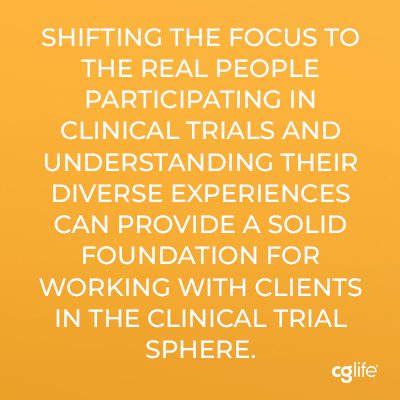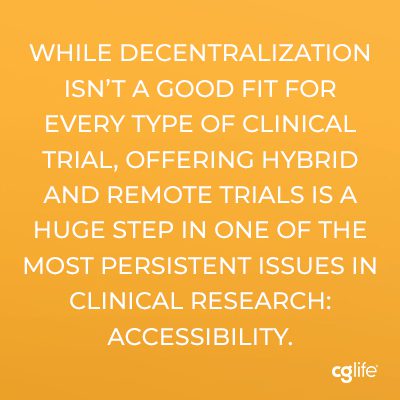As the world anxiously awaited a vaccine against COVID-19, buzz about ongoing clinical trials brought a new level of public attention to clinical research. However, the continued struggle to get Americans vaccinated also highlights the fact that the clinical trial and drug approval process is, for most people, a bit of a black box.
I joined CG Life this spring with a unique perspective on clinical trials, having been both a participant in a Phase 2 clinical trial and a clinical research coordinator (CRC) at Northwestern University’s Robert H. Lurie Comprehensive Cancer Center. Even the scientifically-minded marketing geniuses from CG have been able to take some surprising insights away from my experience, so I wanted to share a few higher-level takeaways on the clinical trial sphere for science marketers.
Being a Subject in a Clinical Trial Might Not Be What You’d Imagined
In healthcare/life sciences marketing, we’re often thinking about a company’s finished product and its impact on the patients it will reach, with a general understanding of the clinical trial pathway that brought us to this point. However, diving deeper into the experiences of more than 100,000 people who volunteer for trials each year can humanize the process and offer a greater appreciation of all that goes into clinical trials.
So, what’s it like to participate in a clinical trial? The short answer: it depends on the phase of the trial and the therapeutic area. The experience of someone in a Phase 3 trial for a new intervention for high cholesterol is very different from that of someone in the Phase 2 trial for a new chemotherapy regimen. The bottom line, though, is that they can be pretty demanding.
As a healthy volunteer in a Phase 2 clinical trial, I reported to study visits at least weekly for a few months, then biweekly, and eventually monthly for about a year and a half. These visits consisted of blood draws, tissue samples, physical exams, and detailed tracking of any medications I’d taken or symptoms I experienced.

Considering that study visits took place during regular business hours, I was fortunate to have the flexibility to participate as a grad student at the large academic medical center where it took place. Interestingly enough, that’s the same reason I was motivated to volunteer in the first place—I was compensated quite well, which was a huge selling point for someone on a modest grad school stipend. Earlier phase studies often compensate subjects, especially healthy volunteers, but the incentive for patients to participate in later-stage trials is often the treatment itself.
For example, many of the leukemia patients I worked with as a CRC had to report to the hospital multiple times each week, sometimes driving hours to get there. If patients couldn’t get time off of work or afford to travel so frequently, they often couldn’t participate, illustrating a fundamental accessibility issue in clinical research.
Being in a clinical trial can offer access to innovative treatments and comprehensive medical attention, but participation also demands a lot from the trial subjects. Shifting the focus to the real people participating in clinical trials and understanding their diverse experiences can provide a solid foundation for working with clients in the clinical trial sphere.
The Day-to-Day Work of Running a Clinical Trial is a Constant Exercise in Multitasking
Clinical research coordinators and clinical research nurses are often the lynchpins of clinical trial success, serving as the study site’s liaison between clinical trial sponsors and the patients participating in a trial. The CRC role comes with a huge range of responsibilities; I often found myself juggling administrative tasks between a schedule of clinical visits, all the while adhering to strict regulatory guidelines and schedules.
This list of responsibilities, coupled with modest salaries and unclear paths for advancement, makes turnover for the position unusually high. While I loved being a CRC, it was admittedly very stressful. I was managing up to ten clinical trials at any given time, screening and scheduling patients, ensuring data were collected properly, and applying constant attention to detail to avoid protocol deviations.
Luckily, a recent wave of new tech tools for managing clinical trials is slowly starting to ease the burden placed on CRCs. Integrated platforms for managing trial recruitment, enrollment, and data collection can make the job a bit easier and ensure the quality and safety of patient data. For marketers working with these companies, a more detailed picture of the needs and struggles of the “boots on the ground” in a clinical trial can make a huge difference in developing the right message.
Clinical Trials Are About To Look Very Different (For the Better!)
It’s becoming increasingly clear that decentralized trials (and the tech that makes them possible) are going to dominate the clinical trial landscape and for good reason. Decentralized clinical trials (DCTs) move away from the traditional model of running all clinical trial activities at a central medical site and into partial or completely remote modalities. More trial activities are taking place in patients’ homes, using telemedicine, electronic assessments, visiting health professionals, and wearable biometric devices to capture real-time health data. Increased reliance on telemedicine during the pandemic has lent greater credibility and familiarity to this approach, and proponents hope that DCTs will continue to thrive past the eventual end of COVID-19.

While decentralization isn’t a good fit for every type of clinical trial, offering hybrid and remote trials is a huge step in one of the most persistent issues in clinical research: accessibility.The flexibility of DCTs makes clinical research a care option for those who traditionally were limited by distance, cost of travel, and family/work obligations. This, in turn, will contribute to the FDA’s recent research priorities, such as increasing the collection of real-world data and reaching a wider, more diverse patient population in trials. DCTs can democratize clinical trials, giving more people access to this care option and collecting more thorough data to develop the best treatments possible, and that’s something we can all get behind.
When I started at CG Life, I was a total newbie to marketing. Though I still have a lot to learn, I’ve been blown away by how useful my clinical trial experience has been in working with our clients and providing clarification to my colleagues when needed. Hopefully, these points give my fellow marketers some food for thought and inspire you to learn more about the ins and outs of clinical trials— maybe from the perspective of those on the inside.
